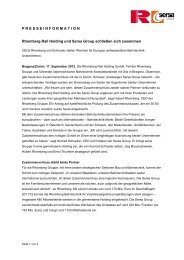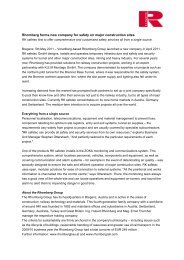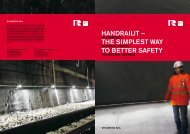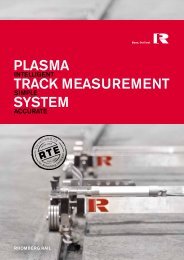Installation Quality of Slab Track â A Decisive Factor for Maintenance
Installation Quality of Slab Track â A Decisive Factor for Maintenance
Installation Quality of Slab Track â A Decisive Factor for Maintenance
You also want an ePaper? Increase the reach of your titles
YUMPU automatically turns print PDFs into web optimized ePapers that Google loves.
<strong>Installation</strong> <strong>Quality</strong> <strong>of</strong> <strong>Slab</strong> <strong>Track</strong> –<br />
A <strong>Decisive</strong> <strong>Factor</strong> <strong>for</strong> <strong>Maintenance</strong><br />
<strong>Slab</strong> track is being adopted in ever increasing volume as the preferred <strong>for</strong>m<br />
<strong>for</strong> new construction and <strong>for</strong> major track renewal. Its first cost is generally<br />
higher than <strong>for</strong> ballasted track types, but RAMS analysis shows that there are<br />
economic advantages in using slab track, provided that maintenance costs are<br />
kept at a very low level by a high quality <strong>of</strong> first construction.<br />
Fig. 1: <strong>Slab</strong> track<br />
systems<br />
<strong>Slab</strong> <strong>Track</strong> Types<br />
A few years ago, slab track was seen in<br />
Europe as a risk-laden and probably very<br />
expensive solution <strong>for</strong> especially difficult<br />
situations in railway infrastructure. This<br />
was due partly by the limited extent <strong>of</strong><br />
Dipl.-Ing.<br />
Dr. Rudolf Schilder<br />
Division Manager<br />
Construction & <strong>Maintenance</strong><br />
Address: ÖBB-Infrastruktur Bau AG,<br />
Engineering Services,<br />
Wien/Austria<br />
E-mail: rudolf.schilder@bau.oebb.at<br />
experience in ballastless track<br />
construction, and also by the lack <strong>of</strong><br />
optimisation <strong>of</strong> the construction process,<br />
as nearly every project seemed to be an<br />
experimental task.<br />
However since those times a whole range<br />
<strong>of</strong> ballastless track types has been<br />
developed, proving their worth in daily<br />
Dipl.-Ing.<br />
Dirk Diederich<br />
Strategic<br />
Project Development<br />
Address: Rhomberg Bahntechnik Group,<br />
Bregenz/Austria<br />
E-mail: dirk.diederich@rhombergbau.at<br />
railway operation. On the Japanese<br />
Shinkansen system, pre-cast slab units<br />
predominate now as they did in the past.<br />
In Europe, as well as the pre-cast slab<br />
types (ÖBB-Porr, Bögl), designs with<br />
concrete sleepers in in-situ concrete<br />
(Rheda variations) and rail support blocks<br />
(LVT) are to the <strong>for</strong>e. Fig. 1 gives a<br />
summary <strong>of</strong> the various types.<br />
It is not only the track <strong>for</strong>m, but also the<br />
construction method that has been<br />
developed in the intervening time.<br />
Construction takes place in ever-shorter<br />
time intervals, and installation quality is<br />
enough <strong>for</strong> the toughest standards –<br />
provided that the construction plant is<br />
appropriate and site supervision is tight<br />
(fig. 2).<br />
<strong>Slab</strong> track has further advantages: it<br />
allows the full width <strong>of</strong> the track to be<br />
used by road vehicles. In tunnel situations<br />
this can be used <strong>for</strong> safety and rescue<br />
76<br />
Special (2007)<br />
76_78_Diederich_Schilder.indd 76<br />
04.07.2007 15:11:05 Uhr
<strong>Installation</strong> <strong>Quality</strong> <strong>of</strong> <strong>Slab</strong> <strong>Track</strong> – A <strong>Decisive</strong> <strong>Factor</strong> <strong>for</strong> <strong>Maintenance</strong><br />
purposes. Special <strong>for</strong>ms <strong>of</strong> slab track are<br />
effective at minimising noise and vibration<br />
emission from railway operation.<br />
Where the maintenance requirement <strong>for</strong><br />
slab track is really significantly lower than<br />
<strong>for</strong> traditional ballasted track, then in<br />
certain situations it can provide an<br />
economic technical alternative.<br />
<strong>Quality</strong> <strong>of</strong> Execution<br />
and Life Cycle Costs<br />
Although the technical aspects <strong>of</strong> slab<br />
track have been optimised, the cost <strong>of</strong><br />
actual construction has barely been<br />
reduced. Neither the cost <strong>of</strong> materials nor<br />
the labour cost has been significantly<br />
reduced.<br />
Inevitably this has resulted in installation<br />
<strong>of</strong> slab track in Germany being confined<br />
mainly to high speed routes until recently,<br />
such as the major high speed routes<br />
Hanover – Berlin, Cologne – Frankfurt and<br />
Nuremberg – Ingolstadt. A decisive factor in<br />
that decision was the requirement <strong>for</strong><br />
smooth running <strong>of</strong> the trains.<br />
However other factors like high availability,<br />
and above all ground condition and<br />
trackside issues are increasingly taking<br />
prominence. In particular, in areas where<br />
access is especially difficult, such as in<br />
tunnels, slab track is being increasingly<br />
installed even on routes without highspeed.<br />
This is not only the case <strong>for</strong> new<br />
construction, but increasingly during major<br />
track renovation works, where the <strong>for</strong>merly<br />
existing ballasted track is replaced with<br />
slab track. In Austria, standards <strong>for</strong> design<br />
on high capacity routes require slab track<br />
to be installed in tunnels, in low-lying route<br />
sections, and on bridges over 500 m in<br />
length. In Switzerland too, ballastless track<br />
finds widespread application.<br />
Fig. 2: <strong>Slab</strong> track construction LVT in the Loetschberg base tunnel<br />
Photo: Rhomberg Bahntechnik Gruppe<br />
construction cost but also the economic<br />
upkeep <strong>of</strong> the infrastructure in operation<br />
has to be evaluated precisely.<br />
For this reason, RAMS-analysis (reliability,<br />
availability, maintainability, safety) is<br />
increasingly used. General contractors<br />
have to make all their specifications and<br />
designs comply with RAMS phases 1 to 14<br />
under Standard EN 50126, dealing with<br />
the long-term operational maintenance <strong>of</strong> a<br />
system; this deals with the life cycle<br />
(concept, construction, testing,<br />
decommissioning). For the major project<br />
Gotthard-Basistunnel <strong>for</strong> example, phases<br />
1 to 4 were required <strong>for</strong> the description <strong>of</strong><br />
the railway technological elements from<br />
Alptransit Gotthard AG. Where construction<br />
involves the integration <strong>of</strong><br />
telecommunications, signalling<br />
technologies and data processing, the<br />
CENELEC standards apply to RAMS.<br />
For purely economic evaluation <strong>of</strong> the<br />
various construction types, life cycle<br />
costs (LCC) also have value. <strong>Slab</strong> track,<br />
because <strong>of</strong> its very low maintenance<br />
requirement, has an advantage over<br />
traditional ballasted track that has been<br />
long understood, but only recently<br />
evaluated. An example <strong>of</strong> the development<br />
<strong>of</strong> the evaluation <strong>of</strong> ballasted and slab<br />
track types using discounted cash flow<br />
methods is shown in fig. 3.<br />
This is not based on the technical<br />
advantages <strong>of</strong> slab track, but on<br />
considerations <strong>of</strong> cost. Whereas <strong>for</strong>merly<br />
only the capital cost was considered, the<br />
operational and maintenance costs <strong>of</strong> a<br />
route throughout its life cycle are now<br />
taken into account.<br />
The increasing requirements <strong>for</strong> new and<br />
upgraded routes, and above all novel<br />
<strong>for</strong>ms <strong>of</strong> project structure <strong>for</strong>ce a whole-life<br />
analysis <strong>of</strong> railway infrastructure costs. In<br />
the so-called Public-Private Partnerships<br />
(PPP), the construction company has to<br />
guarantee operation over a long period;<br />
and to a large degree their pr<strong>of</strong>it depends<br />
on achieving levels <strong>of</strong> availability <strong>of</strong> the<br />
infrastructure. Consequently not only the<br />
Fig. 3: Time depending value, ballasted track and slab track<br />
77<br />
Special (2007)<br />
76_78_Diederich_Schilder.indd 77<br />
04.07.2007 15:11:08 Uhr
<strong>Installation</strong> <strong>Quality</strong> <strong>of</strong> <strong>Slab</strong> <strong>Track</strong> – A <strong>Decisive</strong> <strong>Factor</strong> <strong>for</strong> <strong>Maintenance</strong><br />
Whether slab track will live up to its<br />
promise <strong>of</strong> being almost maintenance<br />
free, and whether the hoped-<strong>for</strong> financial<br />
advantages will actually accrue, depends<br />
on several factors. The most frequently<br />
asked question in this context is which<br />
type <strong>of</strong> slab track is best <strong>for</strong> particular<br />
circumstances. Especially in Germany<br />
there seems to have been a real<br />
mushrooming <strong>of</strong> slab track types in the<br />
last fifteen years. As already suggested,<br />
variants with pre-cast slabs or with<br />
sleepers fixed in in-situ concrete, or using<br />
individual rail supports have prevailed.<br />
Other types have either been used in much<br />
reduced volumes, or completely<br />
abandoned.<br />
The causes <strong>of</strong> this are not so much the<br />
functionality or the structure <strong>of</strong> the<br />
respective track type, but the speed and<br />
quality <strong>of</strong> execution. Many design types<br />
which seemed to <strong>of</strong>fer so much promise<br />
from their basic concept, lost ground<br />
because <strong>of</strong> poor construction quality and<br />
the resulting maintenance costs. In<br />
addition, there is still plenty <strong>of</strong><br />
opportunity <strong>for</strong> error at the installation<br />
stage <strong>of</strong> the “established” systems, and<br />
this can easily negate the hoped-<strong>for</strong> goal<br />
<strong>of</strong> zero maintenance, undermining at the<br />
same time the planned beneficial cost<br />
projections.<br />
The selection <strong>of</strong> a design brings with it not<br />
just the quality <strong>of</strong> installation but also<br />
subsequent maintenance requirement, so<br />
that as well as considerations like “topdown<br />
or bottom-up?” issues like ease <strong>of</strong><br />
replacement and reparability come into<br />
question.<br />
Equally important are the issues <strong>of</strong><br />
carrying capacity and de<strong>for</strong>mation<br />
<strong>of</strong> the sub-grade, as slab track has only<br />
a very limited scope <strong>for</strong> vertical<br />
adjustment. In the case <strong>of</strong> systems<br />
that have sleepers or support blocks<br />
directly fixed into in-situ concrete,<br />
loosening or breaking out is possible;<br />
the development history <strong>of</strong> these types<br />
confirms this observation. Construction<br />
processes like the placing, curing<br />
and subsequent working <strong>of</strong> the concrete<br />
must have the most careful supervision,<br />
as subsequent re-work to rectify<br />
errors can be hugely expensive and<br />
difficult.<br />
Summary<br />
For the reasons given, it is not possible<br />
to give a generally applicable<br />
recommendation <strong>for</strong> a “best-buy” slab<br />
track type. The selection process must<br />
give close attention to the planned use <strong>of</strong><br />
the track, local conditions and project<br />
structure.<br />
Construction <strong>of</strong> slab track needs the<br />
highest levels <strong>of</strong> supervision, and this is<br />
very <strong>of</strong>ten underestimated. Construction<br />
quality is decisive in maintenance<br />
requirements <strong>of</strong> all track types.<br />
Carefully carried out using high quality<br />
standards, slab track <strong>of</strong>fers considerable<br />
advantages over ballasted track types,<br />
from both economic and technical<br />
standpoints. <strong>Slab</strong> track that is installed<br />
using high quality processes can deliver<br />
economic advantages that repay the high<br />
initial cost: and it has beneficial<br />
application in a much wider range <strong>of</strong><br />
situations than was the case a few years<br />
ago.<br />
Installing <strong>of</strong> prefabricated track panels on the construction site<br />
78<br />
Special (2007)<br />
76_78_Diederich_Schilder.indd 78<br />
04.07.2007 15:11:14 Uhr

















